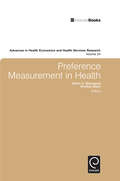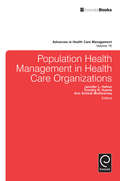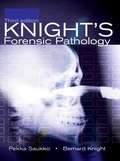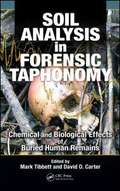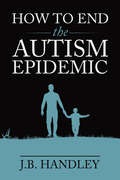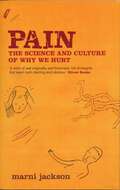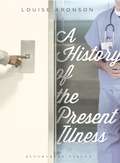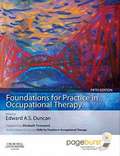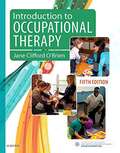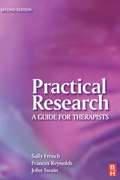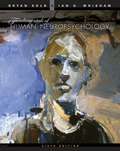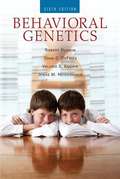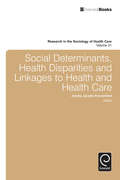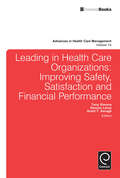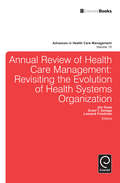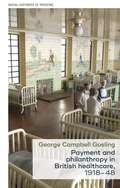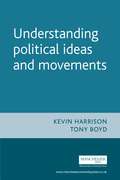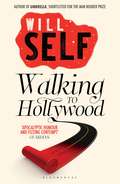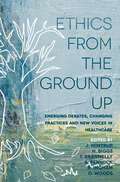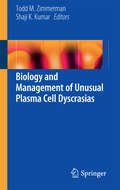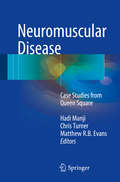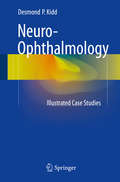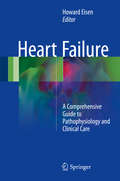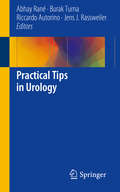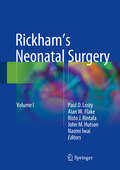- Table View
- List View
Preference Measurement in Health (Advances in Health Economics & Health Services Research #24)
by Glenn C. Blomquist Kristian BolinMeasurements of individual benefits of different health and medical interventions are fundamental for prioritizing among different alternative uses of resources in the healthcare sector. While psychometric measures do not necessarily provide information sufficient for assigning relative values to different health states, preference-based approaches produce measures that allow comparisons of such values. In this volume of the series of Advances in Health Economics and Health Services Research, entitled Preference Measurement in Health, the papers cover altruism within families, differences in risk attitudes, and estimation of health benefits of food safety. Specific topics include efficiency and altruism, comparison of mother and daughter values of HPV vaccination for daughters, differences in risk attitudes between women and men, how context matters in valuing food safety programs, and valuation of health risks associated with pesticide use.
Population Health Management in Health Care Organizations (Advances in Health Care Management #16)
by Timothy R. Huerta Jennifer L. Hefner Ann Scheck McAlearneyThe mission of healthcare organizations has undergone a remarkable transformation from curing disease to caring for the well-being of populations. While health care policy has explored this domain before, notably in Health Maintenance Organizations, the current efforts to create Patient-Centered Medical Homes (PCMHs) and Accountable Care Organizations (ACOs) represent a broader effort to move organizational responsibilities towards population health and care management. Volume 16 of AHCM presents papers that explore this topic across various levels of the healthcare system and employing multiple research designs including case studies, theoretical pieces, secondary data analyses, survey research and qualitative methodologies. Aspects of health care organization discussed in this volume include the PCMH, ACOs, integration with the public health and mental health systems, hospital-physician alignment, and resource planning. Population health management is presented as a factor driving these organizational changes and as a mechanism to facilitate this change.
Knight's Forensic Pathology (PDF)
by Bernard Knight Pekka SaukkoIn this third edition, Knight's Forensic Pathology continues to be the definitive international postgraduate textbook for forensic pathologists, covering all aspects of the medico-legal autopsy, including the cause and time of death, interpretation of wounds and every other facet of the investigation of a fatality. The emphasis is on the practical application of knowledge and research findings, and the new edition continues the often praised traditions of clarity and succinct presentation. This book will be an essential text for all pathologists in training, and remains a standard text to those in practice.
Soil Analysis In Forensic Taphonomy: Chemical And Biological Effects Of Buried Human Remains (PDF)
by Mark Tibbett David O. CarterA burial environment is a complex and dynamic system. It plays host to an abundance of interdependent chemical, physical, and biological processes, which are greatly influenced by the inclusion of a body and its subsequent decay. However, while taphonomy continues to emerge as a valuable forensic tool, until now most of the attention has been on the cadaver rather than the grave itself. Soil Analysis in Forensic Taphonomy: Chemical and Biological Effects of Buried Human Remains is the first book to concentrate entirely on the telling impact of soil and its components on the postmortem fate of human remains. Examining the basic physicochemical composition of the soil as it relates to forensic science and taphonomy, leading experts from across the world― · Offer an introduction to the nature, distribution, and origin of soil materials in forensic comparisons · Discuss the action of biological soil components, including invertebrates, fungi, and bacteria · Address rates and processes of decomposition and time of death estimates · Detail methods for characterizing and fingerprinting soils · Provide extensive information on the decomposition of hair Edited by Mark Tibbett, a soil microbiologist and David Carter, a forensic scientist, this unique resourceprovides an up-to-date overview of fundamental scientific principles and methods used in forensic taphonomy from a soils-based perspective. It provides an understanding of the processes at work, as well as practical methods and advice for those involved with active investigation.
How to End the Autism Epidemic: Revealing The Truth About Vaccines
by J. B. HandleyIn How to End the Autism Epidemic, Generation Rescue’s co-founder J.B. Handley offers a compelling, science-based explanation of what’s causing the autism epidemic, the lies that enable its perpetuation, and the steps we must take as parents and as a society in order to end it. While many parents have heard the rhetoric that vaccines are safe and effective and that the science is settled about the relationship between vaccines and autism, few realize that in the 1960s, American children received three vaccines compared to the thirty-eight they receive today. Or that when parents are told that the odds of an adverse reaction are “one in a million,” the odds are actually one in fifty. Or that in the 1980s, the rate of autism was one in ten thousand children. Today it’s one in thirty-six. Parents, educators, and social service professionals around the country are sounding an alarm that we are in the midst of a devastating public health crisis—one that corresponds in lockstep with an ever-growing vaccine schedule. Why do our public health officials refuse to investigate this properly—or even acknowledge it? In How to End the Autism Epidemic, Handley confronts and dismantles the most common lies about vaccines and autism. He then lays out, in detail, what the truth actually is: new published science links the aluminium adjuvant used in vaccines to immune activation events in the brains of infants, triggering autism; and there is a clear legal basis for the statement that vaccines cause autism, including previously undisclosed depositions of prominent autism scientists under oath. While Handley’s argument is unsparing, his position is ultimately moderate and constructive: we must continue to investigate the safety of vaccines, we must adopt a position of informed consent, and every individual vaccine must be considered on its own merits. This issue is far from settled. By refusing to engage with parents and other stakeholders in a meaningful way, our public health officials destroy the public trust and enable the suffering of countless children and families.
Pain: The Fifth Vital Sign
by Marni JacksonWhy is pain so poorly understood? Why do we still distinguish between mental pain and physical pain, when pain is always an emotional experience? How can it be that science is about to clone a human being but still can't cure the pain of a bad back? If pain is the reason why most people visit the doctor, why are most doctors so bad at addressing the problem of suffering? Marni Jackson's PAIN: THE FIFTH VITAL SIGN is a witty, personal and groundbreaking inquiry into the nature, treatment and definition of human pain, one of the most misunderstood and elusive subjects to challenge humankind. In the questing and narrative manner of Oliver Sacks, Jackson takes us back into the history of pain and forward into the possibilities of pain genetics, Jackson brings us stories both of people in pain and the pain pioneers: eccentrics and artists, wrestlers and writers, psychologists and philosophers, nurses and doctors. Above all, Pain makes an elusive subject vivid and readable. We all know what pain is. Now Marni Jackson has given it a voice.
A History of the Present Illness: Stories
by Louise AronsonA busy doctor juggles an errant teenage daughter and a seriously ill father. An elderly immigrant sacrifices his demented wife's well-being to satisfy his son's authority. A trainee becomes delirious with lack of sleep but must learn how to act, and not react, in the face of suffering. A psychiatrist who advocates for the underserved may herself be crazy. Together these deeply humane linked stories - at once funny and honest, incisive and compassionate - explore the impact of illness on real people's lives and offer a portrait of health and medicine like nothing we have read before. Set in hospitals, offices, nursing homes, prisons, family apartments and out and about in the city, A History of the Present Illness creates a world pulsating with life and introduces a striking new literary voice.
Foundations For Practice In Occupational Therapy (PDF)
by Edward A. S. DuncanNow in its fifth edition, the internationally acclaimed Foundations for Practice in Occupational Therapy continues to provide a practical reference tool which is both an indispensable guide to undergraduates and a practical reference tool for clinicians in the application of models and theories to practice. Underlining the importance and clinical relevance of theory to practice, the text provides an excellent introduction to the theoretical basis of occupational therapy. Contributions are given by both academics and expert clinicians. All chapters have been revised and updated, new ones have been written and some pre-existing chapters have new authors. A refined structure uses highlight boxes to indicate the key themes and issues of each chapter and useful reflective questions to help the reader review the issues raised in the chapter.
Introduction To Occupational Therapy (PDF)
by Jane Clifford O'BrienPrepare for success in OT practice with a complete overview of the profession! Introduction to Occupational Therapy, 5th Edition helps you master the roles and responsibilities of the OT practitioner. Content promotes evidence-based OT practice, from client evaluation to planning interventions and goals to reaching optimal outcomes. You'll also learn valuable skills in clinical reasoning and in providing occupational therapy across the client's entire lifespan. Written by experienced educator and author Jane Clifford O'Brien, this comprehensive resource discusses today's OT treatment settings and adds a new chapter on cultural competence. Complete coverage of OT practice prepares you for care in areas such as adult, pediatric, geriatric, and mental health. A broad perspective fits the needs of both Occupational Therapy and Occupational Therapy Assistant students. Case studies and activities in each chapter help you apply concepts and develop problem-solving skills. Emphasis on evidence-based practice helps you learn to think logically and use research literature to formulate diagnoses and treatment plans. The OT Practice Framework provides a sound basis for decision making, defining occupational therapy areas of concern and the OT process. Chapter objectives, key terms, chapter summaries, and review questions highlight important content in each chapter. Student resources on the Evolve companion website include review questions with answers along with crossword puzzles to reinforce what you've learned in the book. NEW content on OT theory and practice includes the latest updates to the Occupational Therapy Practice Framework and OT Code of Ethics. New coverage of the role of certified Occupational Therapy Assistants shows where OTAs are employed, what licensure requirements they must meet, and how they fit into the scope of OT practice. NEW chapter on cultural competence provides the tools you need to work with culturally diverse clients in today's healthcare environment, and includes case studies with examples of cultural competence and its impact on the practice of OT. NEW Centennial Vision commentary provides a 'big picture' view of today's occupational therapy, and shows how OT is becoming a powerful, widely recognized, science-driven, and evidence-based profession as it reaches the age of 100.
Practical Research: A Guide For Therapists (PDF)
by Frances Reynolds Sally French John SwainThe authors discuss how to start research, the range of tools, research methods and approaches which can be applied, as well as how to report and disseminate research findings. Also contained are learning objectives and practical advice to make understanding and practising research easier. Written by well-known authors and researchers in the field, this completely revised and extensively expanded, popular text continues to provide a 'must have' introduction to the world of research.
Fundamentals of Human Neuropsychology (PDF)
by Ian Q. Whishaw Bryan KolbA scholarly guide to human neuropsychology with a clinical focus throughout. Thorough coverage of brain evolution unites the study of its anatomy and physiology with an understanding of its cognitive, experimental and clinical psychological functions. The 6th edition is updated throughout and has a new 4-colour design.
Behavioral Genetics, 6th Edition (PDF)
by Robert Plomin John C. DeFries Valerie S. Knopik Jenae M. NeiderhiserFor over four decades, Behavioral Genetics has explored the crossroads where psychology and genetics meet, advancing step by step with this dynamic area of research as new discoveries emerge. The new Sixth Edition takes its place as the clearest, most up-to-date overview of human and animal behavioral genetics available, introducing students to the field’s underlying principles, defining experiments, recent advances, and ongoing controversies.
Social Determinants, Health Disparities and Linkages to Health and Health Care (Research in the Sociology of Health Care #31)
by Professor Jennie Jacobs KronenfeldThis volume looks at the key links between social determinants, health disparities and health and health care. There is a particular focus on macro-level systems and micro-level issues, including the examination of issues for patients, carers and providers of care. Coverage includes papers on geographical and place factors and disparities, SES and race/ethnicity factors, chronic care and serious health problems such as HIV/AIDs and kidney transplantation, comparative aspects and perceptions of health disparities. Starting with an introduction that reviews the crucial sociological literature on social determinants and health disparities, papers in this volume go on to cover key themes including ageing, barriers to care, ethnicity, social inequalities, the views of parents on their children's care, and doctor/patient relationships.
Leading In Health Care Organizations: Improving Safety, Satisfaction, and Financial Performance (Advances in Health Care Management #14)
by Tony Simons Hannes Leroy Grant T. SavageHealth care organizations around the world are judged in terms of a health care triple bottom line: ensuring employee and patient safety, maximizing employee and patient satisfaction, and meeting financial goals. Given the increasing burden of chronic diseases, the increasing complexity of medical interventions, and the increasing costs of care, innovative leadership is required to achieve this triple bottom line. The 14th volume of the Advances in Health Care Management research series addresses the links between leadership and safety, satisfaction or financial performance in health care management by exploring questions such as the following: (1) How does leadership impact employee safety? (2) How does leadership affect patient safety? (3) How does leadership impact employee satisfaction? (4) How does leadership affect patient satisfaction? (5) How does leadership affect financial performance? (6) How do health care organizations deploy multi-level leadership to achieve safety goals? Satisfaction goals? Financial goals? Multiple goals? (7) How do health care organization leaders establish and maintain a safety culture? A patient-centered culture? A high performance culture? Combined cultures?"
Annual Review of Health Care Management: Revisiting the Evolution of Health Systems Organization (Advances in Health Care Management #15)
by Leonard H. Friedman Jim Goes Grant T. SavageDramatic changes to the structure of health systems since the 1980s has seen the development of large, integrated health organizations designed to provide scale and scope advantages, improve the quality of care and health outcomes, and provide greater bargaining power relative to payers and large employers. This transition has led to greater interest in understanding hospitals and health systems as complex systems. Two important themes emerged from this effort: 1. Creation and organization of physician-health organizations, and alignment of these organizations with hospital or system structure; and 2. Viewing health care organizations as complex systems, leading to new perspectives on design and management of these organizations. In Volume 15, Reuben McDaniel and L. Robert Burns, authors of two influential articles on these themes from earlier volumes of AHCM, revisit the evolution of health systems organization in light of regulatory and organizational evolution in health care, including the Patient Protection and Accountable Care Act of 2010, and increasing consolidation of health systems. Five additional refereed papers assess the latest evidence on physician integration, complexity, and system redesign.
Payment and philanthropy in British healthcare, 1918–48 (Social Histories of Medicine)
by George Campbell GoslingExamines how commercial medicine operated before the foundation of the NHS, and how this could be compatible with a system based on charity. It challenges the assumptions of historians, politicians and the public.
Understanding political ideas and movements (Understandings)
by Tony Boyd Kevin HarrisonWritten specifically to cover the A2 component of the GCE Government and Politics A-level. Provides a comprehensive introduction to the various political ideas and movements that have shaped the modern world. Underpinned by the work of major thinkers such as Marx, Locke, Weber, Hobbes and Foucault, the book examines at political concepts including the state and sovereignty, the nation and democracy, representation and legitimacy, freedom, equality and rights, obligation and citizenship. Addresses traditional theoretical subjects such as socialism, marxism and nationalism as well as contemporary contemporary movements such as environmentalism, ecologism and feminism. Written in a clear, accessible style, including a number of student-friendly features, such as chapter summaries, key points to consider, definitions and pointers to further sources of information.
Walking to Hollywood: Memories Of Before The Fall
by Will SelfWalking to Hollywood is a dazzling triptych - obsessive, satirical, elegiac - in which Will Self burrows down through the intersections of time, place and psyche to explore some of our deepest fears and anxieties with characteristic fearlessness and jagged humour.'Very Little' is ostensibly the account of a curative journey to Canada and the USA, but in fact the record of a nematode's progress, as the worm of obsession - with scale and packing and the 'stuff' of our lives - bores through a mind in extremesis. 'Walking to Hollywood' is an extreme satire on celebrity, in which the narrator believes that everyone he meets is played by a famous actor, and that only he can solve the mystery of who murdered the movies. 'Spurn Head' leads Self to a tormented sojourn with a madman whose house is sliding over the edge of a cliff, to a game of checkers with Death, and finally to an encounter with one of Swift's immortal Struldbruggs and a march through a tear in time itself. In Walking to Hollywood Will Self pushes memoir to the limits of invention.
Ethics From the Ground Up: Emerging debates, changing practices and new voices in healthcare
by Tula Brannelly Julie Wintrup Hazel Biggs Angela Fenwick Roger InghamThis indispensable textbook explores the ethics of issues from the interpersonal to the political. Expanding on the traditional approach, the editors bring together a range of new perspectives on ethics that reflect the real life experiences and interests of those who work in health and care. Rather than describing abstract ideas and applying them to situations, this authoritative new book uses the everyday situations that occur in health and care as its starting point to examine how we can use our understanding of the moral implications of these to improve practice, relationships and decisions making.
Biology and Management of Unusual Plasma Cell Dyscrasias
by Todd M. Zimmerman Shaji K. KumarThis unique book focuses on the non-myeloma plasma cell dyscrasias. A key resource for this group of diseases, the book features the latest in emerging knowledge and therapeutic developments, including novel therapies. Each disease-specific chapter discusses biology, disease course, and appropriate therapeutic interventions, covering plasma cell leukemia, plasmacytoma, POEMS Syndrome and Castleman's Disease, Waldenström macroglobulinemia, immunoglobin deposition disease, and cryoglobulinemic syndromes, among others. The only book dedicated to this intriguing family of diseases, Biology and Management of Unusual Plasma Cell Dyscrasias will be a long-lasting reference for clinicians and scientists alike.
Neuromuscular Disease: Case Studies from Queen Square
by Hadi Manji Chris Turner Matthew R. EvansThis book provides an accessible guide to neuromuscular disorders using case scenarios from the world-renowned MRC Centre for Neuromuscular Diseases at the National Hospital, Queen Square, London, UK. Fifty genetic and acquired disorders are presented in a practical, easy-to-read format, including those that are common and also some which are rare. Each case covers the history, examination and investigations, including neurophysiology, neuroradiology and neuropathology if appropriate. Discussions of each case include the differential diagnosis, useful clinical pointers and a brief summary of the management of the condition. Neuromuscular Disease: Case Studies from Queen Square is aimed at neurology trainees and consultant general neurologists.
Neuro-Ophthalmology: Illustrated Case Studies (Blue Books Of Neurology Ser. #No. 32)
by Desmond P. KiddThis book presents fifty clinical cases in neuro-ophthalmology, some of which are common and some of which are rare. Each case is presented as a diagnostic and management challenge as found in clinical practice. High quality clinical photographs and images bring the cases to life alongside the diagnostic process and management decisions of an experienced specialist. A short summary of important aspects of the pathogenesis and treatment of each disease finishes each case. Neuro-Ophthalmology: Illustrated Case Studies entertains and instructs the reader and is ideal reading for doctors in training in this area, as well as general consultant neurologists and ophthalmologists.
Heart Failure: A Comprehensive Guide to Pathophysiology and Clinical Care (The\clinics #32-1)
by Howard EisenThis comprehensively covers everything from pathophysiology to the evaluation of patients presenting with heart failure to medical management, device therapy, heart transplantation and mechanical circulatory support, and include relevant cardiac imaging studies such as echocardiograms and magnetic resonance imaging studies which could be seen in their entirety as well as pathology slides, hemodynamic tracings and videos of cardiac surgery such as heart transplants and ventricular assist device implantation. Finally, the book would have videos of patients with heart failure, heart transplants or ventricular assist devices, describing their clinical presentation and experiences. It is structured so that it can be used as a guide by physicians studying for the general Cardiology or Advanced Heart Failure and Cardiac Transplantations Boards.
Practical Tips in Urology
by Abhay Rané Burak Turna Riccardo Autorino Jens J. RassweilerPractical Tips in Urology is a compact, illustrated reference which provides the reader with practical tips and advice in managing day-to-day urological issues encountered in a clinical setting. This book draws on practical experience and offers useful information that is often lacking in didactic textbooks of urology and in journal articles. Practical Tips in Urology provides tips in dealing with urological emergencies, elective surgery and common outpatient consultation problems, among other things. Written by experts in the field, Practical Tips in Urology is key reading for all practicing urologists and residents in training.
Rickham's Neonatal Surgery
by Paul D. Losty Alan W. Flake Risto J. Rintala John M. Hutson Naomi LwaiThis book provides a detailed guide to neonatal surgery and its related disciplines including: fetal medicine, fetal surgery, radiology, newborn anaesthesia, intensive care, neonatal medicine, medical genetics, pathology, cardiac surgery, and urology. The book aims to cover all the latest advances in newborn surgery, with contributions from the basic sciences and laboratory research to reflect the steady progress in our current working knowledge and understanding of many neonatal surgical disorders. As huge advances have been made in neonatal surgery in the past decades, ethical issues, long term outcomes, and quality of life are also emphasised. This book is an authoritative reference for surgical residents in training, consultant surgeons, general surgeons with an interest in paediatric surgery, neonatologists, paediatricians, intensive care specialists, and nursing staff.
